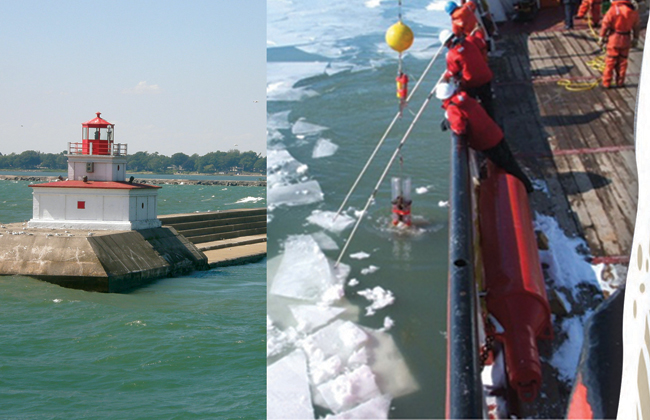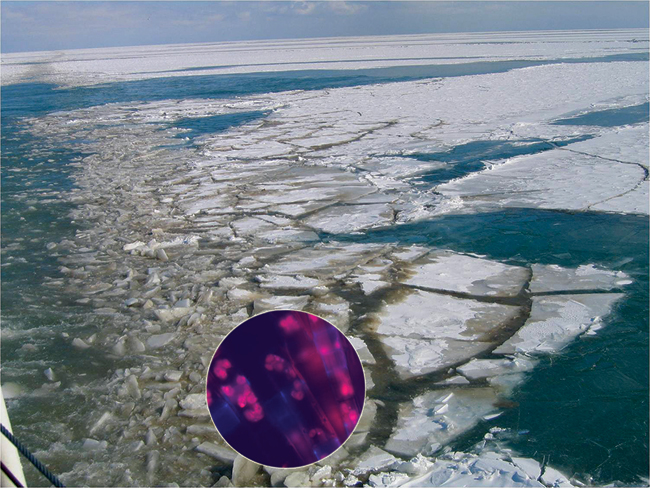
Lake Erie – a sentinel for climate change. A breakwater on Lake Erie
(left) protects the shore near Buffalo.
Photo by Helen Domske.
Researchers (right) sample Lake Erie in winter aboard the Canadian Coast Guard
Cutter
Griffon.
Photo by Michael Twiss
When it’s 20 below,
Dr. Michael Twiss, professor at Clarkson University, has been known to clear the snow and lie down on the thick ice of a frozen lake and stare up at the Northern Lights. But for all his winter preparedness, working on a Canadian icebreaker to collect data for his NYSG-funded research project had its challenges. Bone-chilling February temps caused the shattering of tempered glass collection containers, and the occasional failure of necessary instruments like the CTD sensors that measure conductivity, temperature and depth of sea water. An ice breaker chugging along at 12 mph is a large ship, but it was never meant for research. Twiss and his rugged crew worked in the woodshop where it was warm but noisy as they modified equipment with stainless steel that could withstand the brutal cold.
Why study Lake Erie in the winter? This lake is the Great Lake most impacted by summer hypoxia—the loss of oxygen at the bottom that affects fish and other living communities—and, according to Dr. Twiss, is a good sentinel for climate change. “Lake Erie, the shallowest Great Lake, is also the coldest of all the Great Lakes in winter,” he says. “These extremes make it a good environment to predict how the lakes will change with global climate change.”
As the severity of Lake Erie harmful algal blooms has been on the rise, some would look for a link between summertime algal blooms and hypoxia. Not necessarily so, says Twiss. In fact, his results show that the amount of plankton in wintertime is greater than in summer. By taking ice samples for the last five winters and analyzing for the chlorophyll produced by algae and photosynthetic bacteria, Twiss and his team have determined that from November to April the Lake experiences great primary productivity, more so than in spring or summer.
“We were surprised when we analyzed ‘dirty ice’ which we thought contained just that. Instead it contained chlorophyll, much of it from diatoms.” When they examined the water column for silica –the compound that makes up the hard supporting structure of diatoms—they didn’t find much. Rather, the silica was already mostly accumulated by the diatoms by February when the team was looking, and the winter-blooming diatoms were sinking to the lake sediments. Thus the winter productivity that peaks in December-January creates the source of biomass that starts the decay process and robs the bottom of oxygen. The visible algal blooms, coming months later and making headlines, are really confined to the top surface layers of the lake. They are many meters apart from the hypoxic zones down below.

Productivity in Lake Erie is greater in winter than in summer. The Coast
Guard cutter reveals streaks of brownish silt containing filamentous
diatoms as it cuts through lake ice. Photo courtesy of Michael Twiss
Microscopic inset: Fluorescence is used to show the silica structure
within filamentous diatoms.
Photo courtesy of Matthew Saxton
Twiss and his crew sampled all over the lake from the Canadian Coast Guard Ship
Griffon, despite the winter difficulties. But his research got a boost from
Dr. Caren Binding of Environment Canada, a partner who has been able to use satellite imagery to see algae from space. Dr. Binding has been using the images from NASA and European satellites to monitor the progression of warm weather harmful algal blooms on the surface of Lake Erie since 2004. By looking at the color of the water and other data from tens of thousands of data points, she could determine the timing, intensity and extent of algal blooms. But it wasn’t until she heard Dr. Twiss give results detailing the existence of winter productivity, that she began to look at images from winter months. She accompanied him the next season. The results? The sampling from the
Griffon and the satellite images told the same story: winter productivity is greater than in summer months. Binding says,“You could hear the sound of ice breaking behind you and could see the bloom being released from pockets of ice as a streak of silt and diatoms.” Since this study, Environment Canada has been considering greater research attention to winter productivity.
Dr. Joe DePinto, a senior scientist at LimnoTech in Ann Arbor, Michigan and former professor at U Buffalo and Clarkson, has extensive experience with aquatic research and management programs in the Great Lakes region. DePinto reports that LimnoTech is in the process of finishing the development and application of a Lake Erie Central Basin hypoxia model. In the model, the severity of hypoxia is driven by a combination of physical factors such as the thickness of the dense, bottom layer of water during stratification, the degree of wind-driven vertical mixing, and the growth of phytoplankton induced by phosphorus loading. The phytoplankton generates organic matter that uses oxygen once the algae settle into the bottom of the basin.
Says DePinto, “To the extent that the winter production of phytoplankton organic matter is still available for oxygen-demanding decomposition during the summer stratified period, it will contribute to Central Basin hypoxia. Therefore, we definitely will incorporate this source of organic matter into our model to assess its significance.” Although they are not up to that stage yet, they will work with the Twiss group to do that.
Twiss notes that even in the winter of 2012 when there was no ice cover, the team gleaned much from the data. Says project partner
Dr. Mike McKay, Bowling Green University’s Marine Science Program Director, “We have some interesting data for the winter of 2012. The most distinct trend was a decline in the abundance of large-sized, filamentous diatoms and an increase in small diatoms.” This could likely have implications for the zooplankton that usually graze on larger diatoms and in turn the fish that eat those zooplankton. “However,” says McKay, “We may not know the full effect for a few years when the fish that were depending on winter production from 2012 mature and are enumerated through fish surveys.” Thus the entire lake food web is impacted by the degree of ice cover from year to year and the degree of winter productivity. Perhaps these year to year changes make Lake Erie a living laboratory for climate change.
— Barbara A. Branca